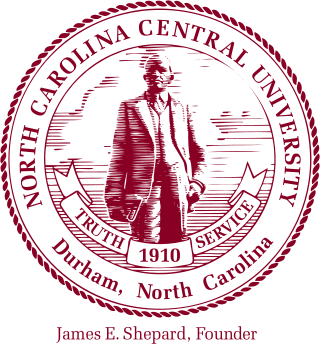
North Carolina is a state in the Southern United States. The state is the 28th largest and 9th-most populous of the United States. It is bordered by Virginia to the north, the Atlantic Ocean to the east, Georgia and South Carolina to the south, and Tennessee to the west. In the 2020 census, the state had a population of 10,439,388. Raleigh is the state's capital and Charlotte is its largest city. The Charlotte metropolitan area, with a population of 2,595,027 in 2020, is the most-populous metropolitan area in North Carolina, the 21st-most populous in the United States, and the largest banking center in the nation after New York City. The Raleigh-Durham-Cary combined statistical area is the second-largest metropolitan area in the state and 32nd-most populous in the United States, with a population of 2,043,867 in 2020, and is home to the largest research park in the United States, Research Triangle Park.
Trinity College may refer to:
Durham most commonly refers to:

The University of North Carolina is the multi-campus public university system for the state of North Carolina. Overseeing the state's 16 public universities and the NC School of Science and Mathematics, it is commonly referred to as the UNC System to differentiate it from its flagship, UNC-Chapel Hill.
Saint John's College or variations may refer to:

Trinity College is one of the constituent colleges of the University of Oxford in England. The college was founded in 1555 by Sir Thomas Pope, on land previously occupied by Durham College, home to Benedictine monks from Durham Cathedral.

Durham is a city in the U.S. state of North Carolina and the county seat of Durham County. Small portions of the city limits extend into Orange County and Wake County. With a population of 283,506 in the 2020 census, Durham is the 4th-most populous city in North Carolina, and the 74th-most populous city in the United States. The city is located in the east-central part of the Piedmont region along the Eno River. Durham is the core of the four-county Durham-Chapel Hill Metropolitan Area, which had a population of 649,903 at the 2020 census. The Office of Management and Budget also includes Durham as a part of the Raleigh-Durham-Cary Combined Statistical Area, commonly known as the Research Triangle, which had a population of 2,043,867 at the 2020 census.
King's College or The King's College refers to two higher education institutions in the United Kingdom:
The U.S. state of North Carolina is known particularly for its history of old-time music. Many recordings were made in the early 20th century by folk song collector Bascom Lamar Lunsford. Influential North Carolina country musicians like the North Carolina Ramblers and Al Hopkins helped solidify the sound of country music in the late 1920s, while influential bluegrass musicians such as Earl Scruggs and Doc Watson came from North Carolina. Arthur Smith had the first nationally syndicated television program which featured country music. He composed "Guitar Boogie", the all-time best selling guitar instrumental, and "Dueling Banjos", the all-time best selling banjo composition. Country artist Eric Church from the Hickory area, has had multiple No. 1 albums on the Billboard 200, including Chief in 2011. Both North and South Carolina are a hotbed for traditional country blues, especially the style known as the Piedmont blues. Elizabeth Cotten, from Chapel Hill, was active in the American folk music revival.

Research Triangle Park (RTP) is the largest research park in the United States, occupying 7,000 acres (2,833 ha) in North Carolina and hosting more than 300 companies and 65,000 workers.

The Research Triangle, or simply The Triangle, are both common nicknames for a metropolitan area in the Piedmont region of North Carolina in the United States, anchored by the cities of Raleigh and Durham and the town of Chapel Hill, home to three major research universities: North Carolina State University, Duke University, and University of North Carolina at Chapel Hill, respectively. The nine-county region, officially named the Raleigh–Durham–Cary combined statistical area (CSA), comprises the Raleigh–Cary and Durham–Chapel Hill Metropolitan Statistical Areas and the Henderson Micropolitan Statistical Area. The "Triangle" name originated in the 1950s with the creation of Research Triangle Park, located between the three anchor cities and home to numerous high tech companies.

North Carolina Central University is a public historically black university in Durham, North Carolina. Founded by James E. Shepard in affiliation with the Chautauqua movement in 1909, it was supported by private funds from both Northern and Southern philanthropists. It was made part of the state system in 1923, when it first received state funding and was renamed as Durham State Normal School. It added graduate classes in arts and sciences and professional schools in law and library science in the late 1930s and 1940s.

School colors are the colors chosen by a school as part of its brand identity, used on building signage, web pages, branded apparel, and the uniforms of sports teams. They can promote connection to the school – or 'school spirit' – and help differentiate it from other institutions.
Saint Mary's College, is the name of several colleges and schools:

Woody Lombardi Durham was an American play-by-play radio announcer for the North Carolina Tar Heels football and men’s basketball programs from 1971 to 2011.

Durham College was a college of the University of Oxford, founded by the monks of Durham Priory in the late 13th century. It was closed at the dissolution of the monasteries in the mid 16th century, and its buildings were subsequently used to found Trinity College, Oxford.

The third-oldest university in England debate has been carried out since the mid-19th century, with rival claims being made originally by Durham University as the third-oldest officially recognised university (1832) and the third to confer degrees (1837) and the University of London as the third university to be granted a royal charter (1836). These have been joined more recently by University College London as it was founded as London University (1826) and was the third-oldest university institution to start teaching (1828) and by King's College London. Most historians identify Durham as the third-oldest, following standard practice in how a university is defined and how this is applied historically, although the popular press is more divided.

U.S. Highway 15 (US 15) is a north–south United States Numbered Highway running from Walterboro, South Carolina, to Painted Post, New York. In the U.S. state of North Carolina, the highway runs for 159 miles (256 km) from the South Carolina state line to the south of Laurinburg to the Virginia state line north of Bullock. US 15 travels in concurrency with US 501 for 106 miles (171 km) between Laurinburg and Durham.

The North Carolina A&T–North Carolina Central rivalry is an ongoing series of athletic competitions between North Carolina Agricultural and Technical State University and North Carolina Central University, both of which are located in North Carolina.












